

17 April 2024
For the first time in one place - the highlights of our Creature of the Month series published in SCUBA News. For more information and indentification notes click a photo.
You can search for more Creatures of the Month on our news site.
Mammals • Turtles • Fish • Coral • Jellyfish & Anemones • Sponges • Cephalopods • Nudibranchs
There are four groups of marine mammals: cetaceans which are the whales, dolphins and porpoises; pinnipeds which are seals, sea lions and walruses, sirenians which are the dugongs and mannatees and the fissipeds which include polar bears and sea otters.
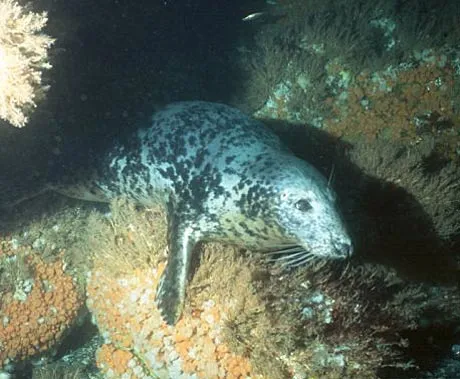
Photo credit Tim Nicholson, taken in the Isle of Man.
Found in: North Atlantic especially Britain.
Grey seals live in the North Atlantic Ocean. Half of the world's population are found on and around British coasts, and numbers here have doubled since 1960. However, the northeast Atlantic population as a whole (from Portugal to Norway and Iceland) is considered to be Endangered. Their lifespan generally ranges from fifteen to twenty-five years, but the oldest recorded living grey seal is 46 years old.
More on Grey Seals....
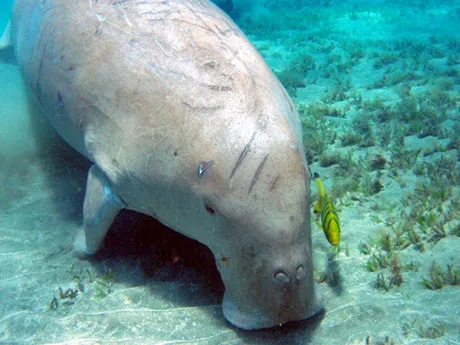
Photo credit Suzanne Challoner, taken in the Red Sea.
Named from the Malay for "Lady of the Sea", Dugongs are said to have inspired the legends of mermaids.
They can eat as much as 40 kg (88 lb) of seagrass
a day, leaving distinctive troughs in seagrass meadows. They live a long time: the oldest dugong yet found was estimated to be over 70 years old. Dugongs have dense, massive bones, which help to keep them submerged. Their lungs lie along their back and act like floats, keeping them horizontal in the water. They are the only representatives left in their family Dugongidae.
More on Dugongs....
Seven species of turtle live in our seas. Six of these are threatened with extinction, and there isn't enough known about the other to decide.
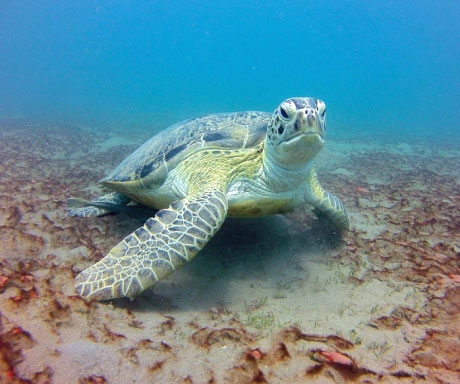
Photo credit David Collins, taken in Marsa Alam, Red Sea.
Found in: tropical and subtropical oceans worldwide
Green turtles can live to 23 years old. The age to maturity appears to be the longest for any sea turtle. Green turtles don't look green - they got the name from when they were regularly eaten because their body fat is a greenish colour. A large turtle, individuals can grow to 120 cm. As they age they move to a vegetarian diet, eating sea grass and algae.
More on Green Turtles....
Fish are vertebrates and live in water, other than that they are very different from each other.
Lionfish | Red Sea Clownfish | Freckled Hawkfish | Spadefish | Batfish | Crocodilefish | Tompot Blenny | Leopard-Spotted Goby | Golden Trevally | Great Barracuda | Spotted Snake Eel | Conger Eel | Geometric Moray Eel | Bull Shark | Giant Manta Ray | Sicklefin Devil Ray | Blue Spotted Stingray

Photo credit Tim Nicholson, taken in the Egyptian Red Sea.
Found in: Native from the Red Sea to South Africa and Indonesia. Now found elsewhere as an invasive species.
Found in the Red Sea and Indian Ocean to the Andaman Sea. Elsewhere replaced by the very similar P. volitans. Usually 11 dorsal rays (those on the top of the fish). A sting from this fish can be very painful, and possibly fatal. They often shelter under ledges during the day, being more active at dusk and during the night when feed on fishes and crustaceans using their non-stinging pectoral fins to shepherd prey into their mouths. The Lionfish's poisonous spines allow it to be conspicuously coloured, warning predators to keep their distance.
More on Lionfish...

Red Sea Clownfish in Bubble Anemone
Found in: Red Sea
The most common clownfish in the Red Sea, hence its name. But it doesn't just live in the Red Sea. You will also find it in the Gulf of Aden and in the Chagos Islands in the Pacific some 3364 km away. But curiously nowhere in between. Clownfish start off male, but if the female dies the dominant male will change into a female. The Red Sea Clownfish lives from the shallows down to 30 m, generally living in pairs in association with an anemeone. The tentacles of the anemone protect the clownfish from predators. At first contact with the anenome the clownfish jerks back, but gradually its mucus coating gives it immunity to the anemone's stinging nematocysts.
More on Red Sea Clownfish....

"Waiting for lunch", photo credit Tim Nicholson, taken in the Red Sea
Found in: Indo-Pacific including Red Sea and East Africa
Seen from 1 to 33 m resting motionless on coral. It is carnivorous, feeding on crustaceans and small fish. A member of the Cirrhitidae family, it can change sex. Young fish are all female. One male has a harem of females - if the male dies one of the females changes sex to take its place. Males are very territorial.
More on freckled hawkfish….

Sabre Squirrelfish, photo credit Tim Nicholson, taken in the Red Sea
Found in: Indo-Pacific including Red Sea and East Africa
The biggest squirrelfish in the world is nocturnal. during the day youll find them under ledges and in caves, away from the light.
More on sabre squirrelfish….
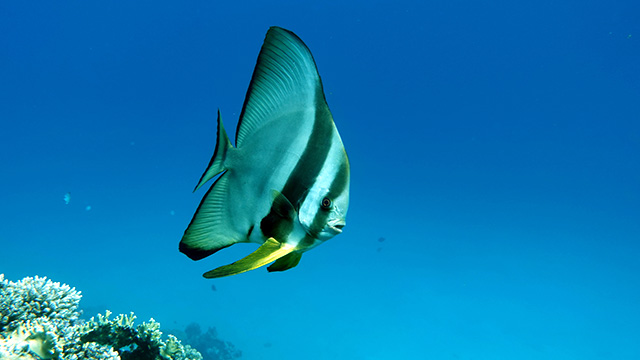
Longfin spadefish. Vitaliy/Depositphotos
Found in: Indo-Pacific including Red Sea
These slow moving fish are not at all intimidated by divers, and often come to greet you on your dive - where to see them and why some of them follow turtles.
More on Spadefish....

Photo credit Tim Nicholson, taken in the Red Sea
Found in western Indian Ocean, including Red Sea & Gulf of Aqaba
A very placid fish which, confident in its camouflage, lets you approach closely. Although related to scorpion fish it is harmless.
More on Crocodilefish….

Tompot Blenney, photo credit Tim Nicholson, taken in the Isle of Man
Found in: Northeast Atlantic, Mediterranean, Sea of Marmora
This charming little fish, with the expressive face, generally looks as if it is either smiling or puzzled. Unusually small for a blenny, you can see them in temperate waters peering out from crevices in reefs or wrecks.
More on Tompot Blenny….
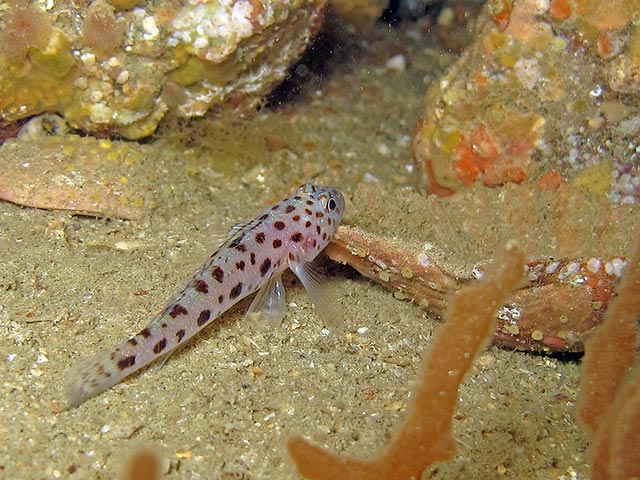
Leopard-Spotted Goby, photo credit Christophe Quintin (CC BY-NC 2.0)
Found in: Mediterranean and Eastern Atlantic
A shy fish, Thorogobius ephippiatus lives in cracks on
steep walls and caves. Shipwrecks are also a favourite habitat. You find them
in the shallows and down to 40 m. It tends to face its crevice home and shoot back in if disturbed, making it difficult to take photos of it face on.
More on Leopard-Spotted Goby….

Found in: the Indo-Pacific, including the Red Sea
If you look carefully at this semi-translucent little fish you can see its organs. The ghost goby lives mainly on stony corals to around 30 m. Its red fluorescent eyes probably helps them forage for their preferred food of miniscule crustaceans (red fluorescence enhances visual contrast at depths below 10 m).
More on Ghost Goby….
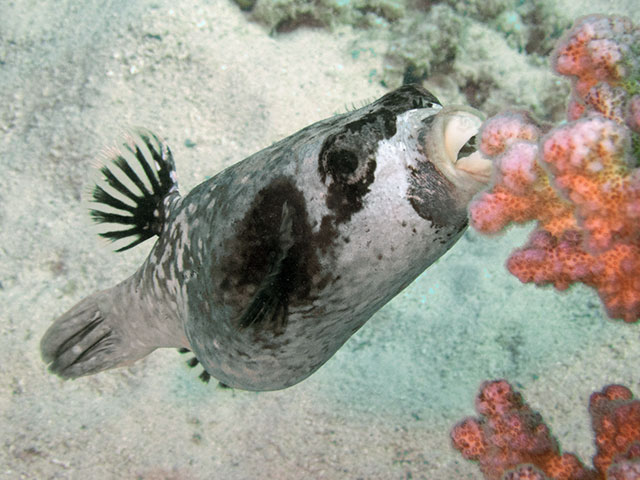
Found in: Red Sea
Distinctive looking, this small pufferfish has a black mask over its eyes and a black mouth. It is common on fringing coral reefs in the Red Sea. They are called pufferfish because when threatened they greatly inflate themselves with water, making themselves look much larger than they usually are. This defence mechanism is important because they move so slowly through the water they would otherwise be easy pickings for predators. Their second line of defence is their toxicity. The Puffer's toxin - tetrodotoxin - is produced within the pufferfish by bacteria. Weight-for-weight, tetrodotoxin is up to 100 times as deadly as the venom of the black widow spider and one of the most poisonous natural substances. Their toxin is used to treat breast cancer.
More on Masked Pufferfish….

Juvenile Golden Trevally with Diver. Photo credit Jill Studholme, Red Sea
Found in: Indo-Pacific
Young Golden Trevally are strikingly coloured, their gold and black striped garb showing from where their name comes. These young fish like to seek out large animals like sharks, groupers and dugongs for protection, acting as pilot fish. Sometimes they make a mistake and decide that a diver is the perfect companion.
More on Golden Trevally….

Photo credit National Park Service
Found in: tropical to warm temperate waters
The Great barracuda is amongst the top predators in their environment and use very highly developed smell and vision senses to locate their prey. When attacking, the barracuda will charge at fast speed (approximately 12 ms-1) and ram their target. They then unleash the power of their jaws which allows them to slice through their prey, even those larger than the barracuda itself.
More on Great Barracuda...
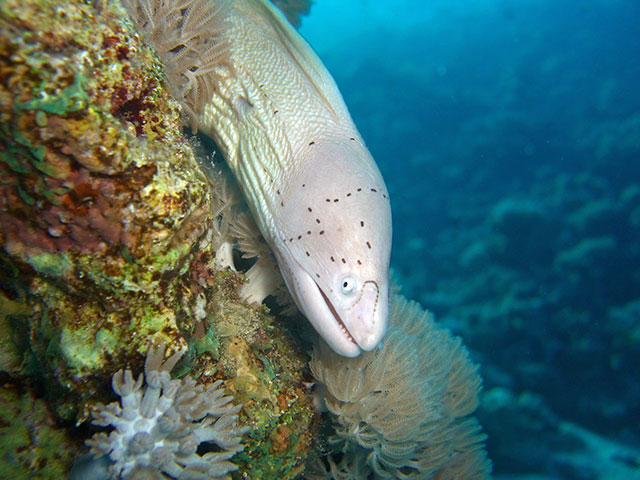
Found in: Indo-Pacific
Small with distinctive face patterns which mark the pores that help the eel detect movement and vibration in the surrounding water. This plus four nostrils and speed of movement make the geometric eel such a good hunter that sneaky groupers hang round them and scavenge on the prey the eels flush out of cracks and crevices in the reef.
More on Geometric Moray Eels...
Found in: Indo-Pacific
When is sea snake not a sea snake? When it's a spotted snake eel. These eels live throughout the Pacific Ocean, from the Red Sea to South Africa and Australia.
More on Spotted Snake Eels...
Found in: Northeast Atlantic and Mediterranean
Congers breed only once in their lives, at between 5 and 15 years of age. They migrate to deep water to spawn some sources say as deep as 4000 m in one or more areas between Gibraltar and the Azores in the mid-Atlantic. After spawning they die, their larvae drifting back into coastal waters.
More on Conger Eels...

Photo credit Pterantula (CC BY 2.5)
Found in: worldwide tropical and subtropical seas plus rivers and lakes
One of the extraordinary things about bull sharks is that they are as happy in freshwater as they are in the sea. They have even been seen far inland up the Mississippi river. Many spend time in the freshwater Lake Nicaragua jumping up the river like salmon to get there.
More on Bull Sharks...
Found in: worldwide
Awesome to see underwater, the Giant Manta Ray is an enormous fish spanning nearly 7 m (22 feet). They live in warm waters around the world, gracefully flying through the water with steady sweeps of their giant wings.

Found in: worldwide but congregate in Azores and the Saint Peter & Saint Paul Archipelago
Sometimes mistaken for manta rays, you can tell these rays apart by their dark green to brown colour. Their "horns" (cephalic fins) point forward rather than curling like the mantas. This is were they got their name "devil ray".

Photo credit: Garry Frazer
Found in:Indo-Pacific
You find this ray on sandy bottom around coral reefs, down to 50 m. They like to lie on the bottom and flick sand over themselves to hide, making it easier for them to prey on molluscs and crabs. For such a commonly seen ray, much about them remains unknown. For instance, nobody knows how long they live (but the lifespan of similar species is around 10 years). They have many names including bluespotted ribbonray, ribbontail stingray, bluespotted fantail ray and blue spotted lagoon ray
Highly intelligent marine molluscs, including octopus, squid and cuttlefish. The name of this group means "head foot", from the Greek. This is because their arms connect to their heads.

Sepia sp. - Cuttlefish
Taken off Agincourt Reef, Australia, by Tim Nicholson.
The cuttlefish has almost incredible powers of mimicry. It can control the colour, patterning and texture of its skin to perfectly match its surroundings. And not just from above, the camouflage works from whichever angle it is observed. From birth, cuttlefish can display at least 13 type of body pattern, made up from over 30 different components.
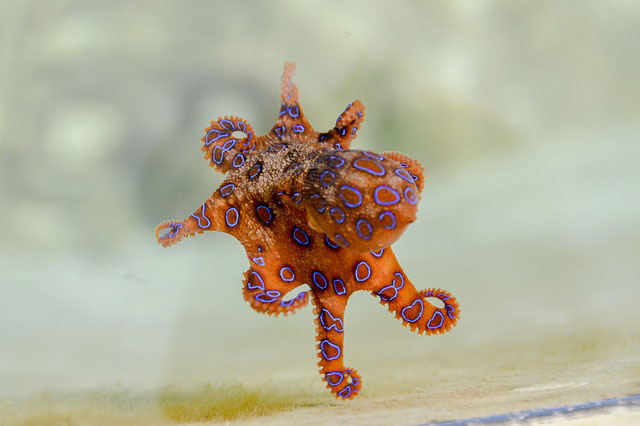
Blue Ringed Octopus. Photo credit: Penny Ash
Found in: Northern Australia and Western Pacific.
The blue-ringed octopus Hapalochlaena lunulata is said to carry enough venom to kill 26 people. These small animals spend much of their time in hiding, camouflaged. But when disturbed, the octopus will flash around 60 beautifully iridescent blue rings and, when strongly harassed, bite and deliver a neurotoxin in its saliva. Don't pick one up.
Also known as sea slugs, brightly coloured nudibranchs are found throughout the world's seas.
Orange Clubbed Nudibranch | Scarlet Lady Nudibranch | Violet Nudibranch

Found in: North East Atlantic - Europe
With orangy-yellow "clubs" around its body, curving inwards over its back, this is a delightful nudibranch. Normally up to 20 mm long. The nudibranch's rhinophores, which it uses to smell or taste, are yellow tipped and lamellate or folded.

Coryphella browni taken on Chickens Rock in the Isle of Man. Photo credit: Tim Nicholson.
Found in: Europe
Coryphella browni has a translucent body and numerous red cerata with white tips, on its back. The inner cerata are longer than the outer. It grows up to 5 cm long. You find it around the British Isles and Northern Europe. There are other species very similar to C. browni, such as Coryphella lineata which is distinguished by white lines down its body and along its cerrata.

Flabellina affinis taken in the Medes Isles, Spain. Photo credit: Tim Nicholson.
Found in the Mediterranean, on the Atlantic coast of France, Spain and Portugal, and in the Canary Islands. This pretty pink nudibranch grows to 5 cm long and feeds on hydroids. Not just any hydroids but only those in the Eudendrium genus like the ones in the photo.
Coral, jellyfish and anemones all belong to the cnidarians group of invertebrates
Lion's Mane Jellyfish | Jewel Anemone | Plumose Anemone | Soft Coral
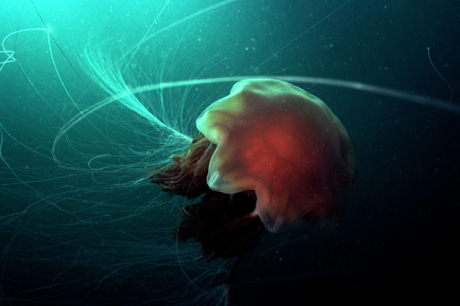
Lion's Mane Jellyfish, taken in the Isle of Man, by Tim Nicholson.
Found in: Arctic, north Atlantic, north Pacific
With tentacles up to three metres long and covered with stinging cells, it's better not to get too close to the Lion's Mane jellyfish. It's body can be 2 metres across, making it one of the largest species of jellyfish.

Jewel anemone, taken in the Azores, by Tim Nicholson.
Found in: northeastern Atlantic Ocean and Mediterranean
These flower-like animals, up to 2.5 cm (1 inch) across, prey on invertebrates which they have paralysed with nematocysts and caught with their 100 ball-tipped tentacles. They favour fast-flowing water, so look for them where strong currents occur from shore level down to around 80 m.

Plumose anemone, taken in the Isle of Man, by Tim Nicholson.
You often see Plumose anemones in large numbers when diving in temperate waters. They comprise a tall, smooth column topped with a crown of feathery tentacles.

Soft coral, Dendronephthya hemprichi taken by Tim Nicholson on the wreck of the Carnatic in the Red Sea
Found in: Red Sea to Western Pacific
This animal is common in the Red Sea and a pioneer settler. It can clone small fragments of itself with root-like processes that let them quickly attach to artificial structures like wrecks. Especially vertical structures. (Our photo was taken on the wreck of the Carnatic.) One of the Nephtheidae family, the soft coral takes in sea water to expand its body before feeding. This builds up a positive pressure inside the coral that supports the branches and trunk. Unlike most other corals, D. hemprichi don't depend on symbiotic algae: they are azooxanthellate (asymbiotic). Instead they feed almost exclusively on phytoplankton.
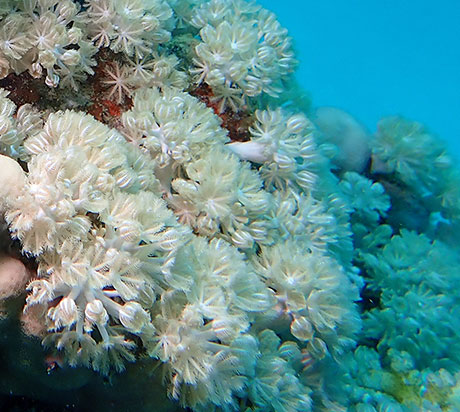
Xenid Coral, Xenia umbellata taken by Jill Studholme at Marsa Shona, Red Sea
Found in: Red Sea, Madagascar, South Africa
If you've dived in the Red Sea or Indo-Pacific you will have seen pulsating soft coral repetitively "grabbing" at the water. They are so common that we take them for granted. But only one family of coral does this - the Xeniidae. Even within this family, only a few members pulsate.

Found in: Red Sea to Western Pacific
A gorgonia. Growing at right angles to the prevaling current, their tentacles strain microscopic particles of food from the water. When currents threaten to damage a colony, they can bend and then spring back into their original position. The giant sea fans take 10 to 15 years to reach their maxium size. Sea fans are actually colonies of many small individual polyps connected together to form a lacey sheet.
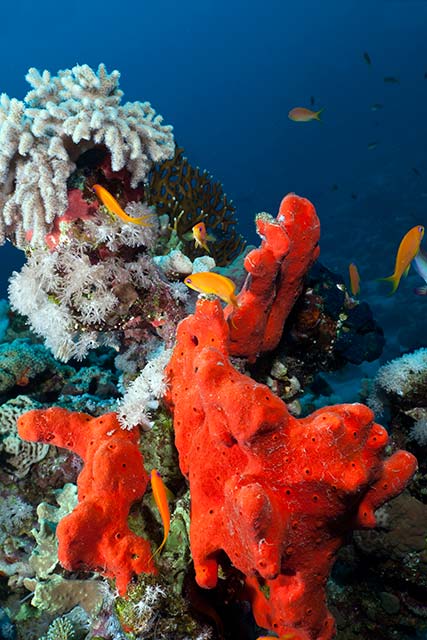
Found in: North Sea, Red Sea, Mediterranean Sea, Black Sea, Caribbean Sea, Atlantic and Pacific, in depths below 10 m.
The fascinating excavating, recycling, anything-but boring, boring sponge. Not always red, you often see them is shades through orange to yellow.
This page is regularly updated. Our newsletter, SCUBA News (ISSN 1476-8011), will let you know when. To receive your copy fill in your details below. We will not pass your e-mail address to any third parties, nor send you unsolicited e-mail.
To receive your copy fill in your details below. We will never pass your e-mail address to any third parties, or send you unsolicited e-mail.